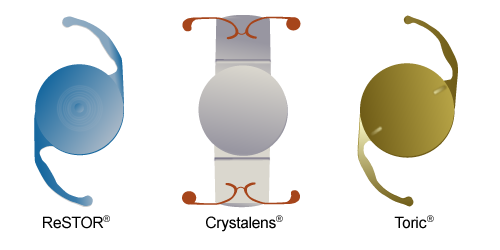In the days before intraocular lenses (IOLs), patients were required to wear very thick eyeglasses or special contact lenses to be able to see after cataract surgery. With today’s advanced procedures, cataract surgery not only replaces your natural lenses to eliminate the effects of cataracts but can help you to enjoy the benefits of improved vision.
Just as in the lenses of your prescription glasses, IOLs are customized to your vision needs, giving you the best vision possible. The process is straightforward:
- Before surgery, your ophthalmologist will measure your eyes to calibrate the prescription of your IOL. Depending upon your preferences about wearing reading (or near vision) glasses, you and your doctor can decide which IOL type is best for you.
- Remember, the type of IOL you choose will directly impact your ability to see without glasses. You may still need glasses for some activities.
- If you have astigmatism, you may need to discuss what is called a ‘toric’ IOL specifically designed for that condition, as well as related treatment options.
- In certain cases, cost may be a limiting factor but if you have the option of selecting special premium lOLs, they will reduce your need for glasses.
Several different types of IOLs are available, each with distinct advantages depending upon your visual circumstances:
Monofocal Lenses have been around for several decades and usually are predicated on a decision to see near or far distances. That is, if your IOL is prescribed for distance vision, you will supplement with reading glasses. Conversely, if you prefer an IOL set for near vision, you will require long distance glasses. These implants do not focus at multiple ranges.
Some patients opt to have different prescriptions in each eye, a strategy known as ‘monovision’. Incredibly, the brain learns to synthesize the messages from each eye to promote vision at intermediate distances, often minimizing the use of reading glasses. Those who seek crisp and detailed vision may not find this strategy appealing but many may see at most distances with less need for eyeglasses.
Multifocal or accommodative lenses may reduce or eliminate the need for glasses. This IOL is designed with a series of focal zones which may enable the patient to see both near and distant objects clearly. Allowing certain eye muscles to move the IOL forward and backward, much like the eye’s natural lens, it is generally placed in both eyes.
Toric monofocal IOL for astigmatism mitigates this eye condition that distorts or blurs both near and distant objects due to an elongated cornea. Patients who suffer from a high degree of astigmatism should opt for this implant.
For some patients with mild astigmatism who would like to reduce their reliance on eyeglasses, the femtosecond laser may be used to create accurate corneal incisions that allows the cornea to resume a shape that is both rounder and more.
Protective IOL filters protect the retina from UV rays and other harmful light radiation. Depending upon a patient’s specific environment, the appropriate filter will be used.
The clear lenses of an IOL eliminate the cloudiness of cataracts but they can do much more to improve your vision and your life. When you decide to undergo cataract surgery, make sure to ask your doctor about the many other benefits of IOLs.
